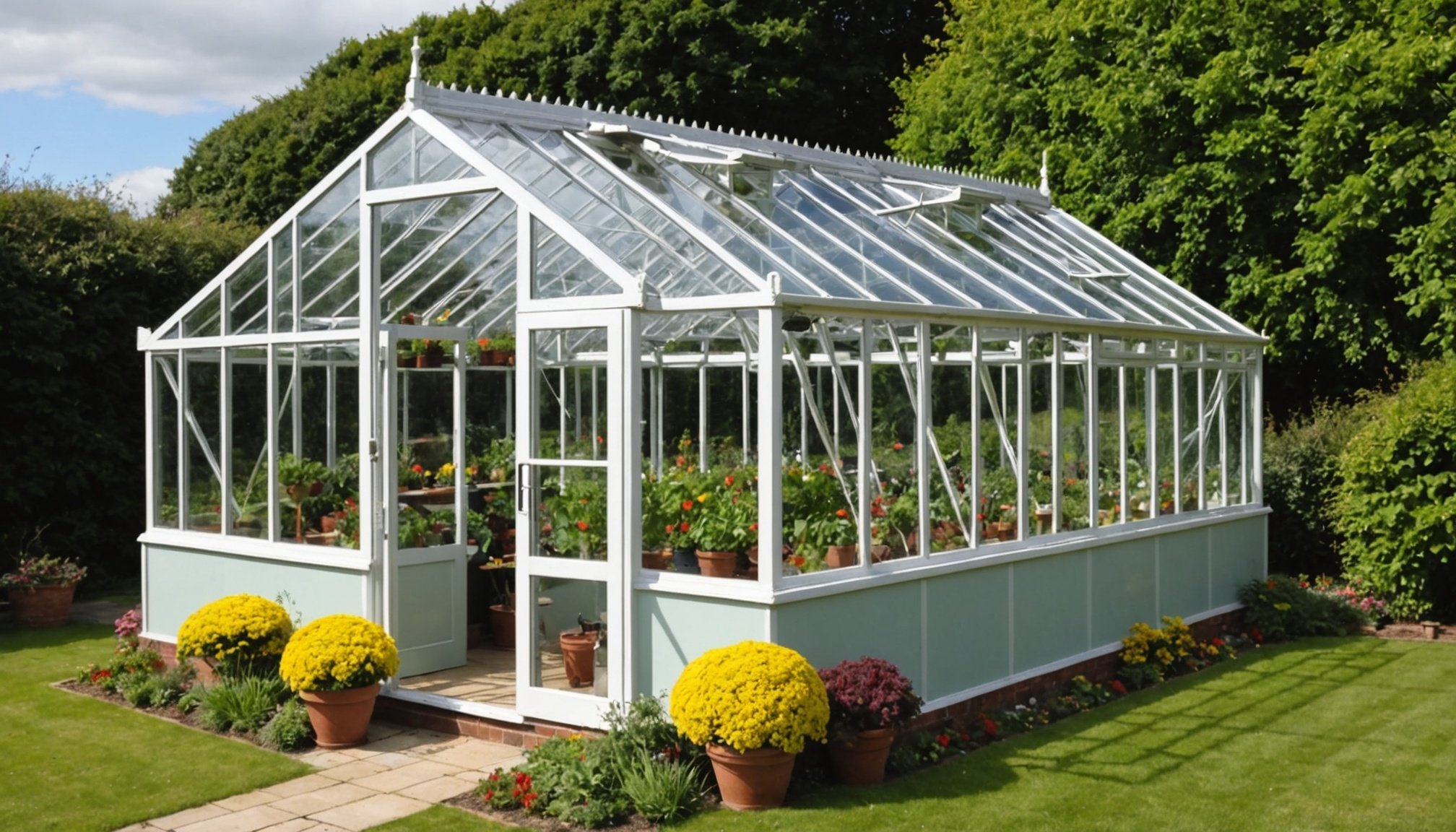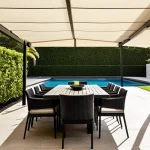Choosing the right greenhouse for windy coastal conditions in the UK is essential for successful gardening. These environments present unique challenges, including strong winds and salt exposure, which can damage less durable structures. Understanding the specific needs for ventilation, material selection, and design will ensure your greenhouse thrives despite the elements. This guide will provide practical insights to help you select a greenhouse tailored to withstand coastal winds, allowing you to cultivate a flourishing garden year-round.
Understanding Windy Coastal Conditions
Windy coastal environments present unique challenges and opportunities for greenhouse cultivation. These areas are characterised by strong winds, high humidity, and the presence of saltwater, all of which can significantly impact greenhouse structures.
A voir aussi : Step-by-Step Guide to Installing Sustainable Wool Carpeting in Your Brighton Home
Characteristics of Windy Coastal Environments
Coastal regions are often exposed to persistent winds that can stress and damage greenhouse structures. The saltwater carried by these winds can lead to corrosion of metal frames and other materials, necessitating the use of corrosion-resistant materials. High humidity levels are also a defining characteristic, which can promote the growth of mould and mildew if not properly managed.
Avez-vous vu cela : Crafting a Comfortable and Efficient Ergonomic Home Office in Your Cozy Edinburgh Apartment
Impact of Saltwater and Humidity
The combination of saltwater and humidity requires careful planning and maintenance. Saltwater can accumulate on surfaces, leading to deterioration over time. Greenhouses in these areas must be designed with materials that withstand these conditions, such as treated wood or galvanised steel. Humidity control is also crucial to prevent plant diseases and ensure optimal growing conditions.
Importance of Location and Microclimates
Choosing the right location for a coastal greenhouse is critical. Understanding the local microclimates can help in selecting a site that offers natural protection from prevailing winds. Additionally, strategic placement can take advantage of natural windbreaks, reducing the impact of harsh coastal conditions and promoting successful cultivation.
Key Features to Look for in a Greenhouse
When selecting a greenhouse for windy coastal conditions, several essential features should be prioritised to ensure durability and functionality.
Structural Integrity and Design Considerations
Ensuring the structural integrity of your greenhouse is crucial. Opt for designs that incorporate reinforced frames and durable materials to withstand strong winds. The shape and orientation of the greenhouse can also influence its ability to resist wind damage. Structures with streamlined designs are less likely to experience wind resistance, reducing the risk of structural failure.
Importance of Proper Ventilation Systems
Proper ventilation systems are vital for maintaining a healthy growing environment. In high humidity coastal areas, effective ventilation helps control moisture levels, preventing mould and mildew growth. Look for greenhouses with adjustable vents and fans that can be adapted to changing weather conditions. This adaptability ensures that plants receive adequate air circulation, promoting optimal growth.
Effective Anchoring Solutions for Stability
Stability is another critical factor for greenhouses in windy regions. Implementing effective anchoring solutions is essential to prevent the structure from being uprooted during storms. Consider using ground anchors or concrete footings to secure the greenhouse firmly. These solutions provide the necessary stability and peace of mind, ensuring that your greenhouse remains intact and functional despite challenging environmental conditions.
Best Greenhouse Types for High Winds
Selecting the right greenhouse type is crucial for ensuring resilience in windy coastal environments. Each design offers unique benefits and challenges, making it essential to consider your specific conditions.
Hoop Houses
Hoop houses are popular for their simplicity and cost-effectiveness. Their curved shape naturally deflects wind, reducing stress on the structure. However, they may require additional reinforcement in extremely windy areas.
A-Frame Greenhouses
A-frame greenhouses feature a triangular design that provides excellent wind resistance. The sloped sides help to minimise wind impact, making them a robust choice for coastal locations. While they offer superior strength, their construction can be more complex and costly.
Geodesic Domes
Geodesic domes are renowned for their structural integrity and ability to withstand high winds. The dome shape distributes wind pressure evenly, preventing weak points. They are highly durable but can be more challenging to construct and may require specialised materials.
Recommendations:
- For budget-friendly options, consider reinforced hoop houses.
- A-frame greenhouses are ideal for moderate to high wind areas.
- Geodesic domes provide maximum protection but may involve higher initial investment.
Choosing the right greenhouse type will ensure longevity and success in challenging coastal conditions.
Material Choices for Durability
Selecting the right greenhouse materials is essential for durability in windy coastal conditions. The choice between glass and polycarbonate is significant. Glass offers clarity and aesthetic appeal, but it is heavy and can shatter under stress, making it less ideal for high-wind areas. Polycarbonate, on the other hand, is lightweight and impact-resistant, providing a safer, more practical option for coastal greenhouses.
Reinforced frames are crucial to withstand the harsh winds typical of coastal environments. Using materials like galvanised steel or aluminium can enhance the structural integrity of the greenhouse. These materials not only resist corrosion from saltwater but also provide the necessary support to withstand strong gusts.
In addition to structural concerns, consider insulation and energy efficiency in your material choices. UV-resistant coatings on polycarbonate help maintain temperature control by reducing heat loss and protecting plants from excessive sunlight exposure. This feature is particularly beneficial in coastal areas where temperature fluctuations can occur.
When planning your greenhouse, prioritise materials that offer a balance of strength, durability, and energy efficiency. This approach ensures your greenhouse can endure the challenges of a windy coastal environment while supporting healthy plant growth.
Installation Tips for Windy Conditions
When installing a greenhouse in windy coastal regions, careful planning and execution are essential to ensure stability and longevity. Begin with site selection and preparation. Choose a location that naturally shelters the greenhouse from prevailing winds, such as a spot near a natural windbreak like a hill or a line of trees. Preparing the site involves levelling the ground and ensuring proper drainage to prevent water accumulation, which can weaken the foundation.
Securing the greenhouse frames is crucial. Use heavy-duty anchors or concrete footings to firmly fix the structure to the ground. This prevents the greenhouse from being uprooted during strong winds. Reinforce the frame with additional bracing if necessary, focusing on areas that experience the most wind pressure.
Always adhere to the manufacturer guidelines during installation. These guidelines provide specific instructions on assembling and securing the greenhouse, tailored to the design and materials used. Following these instructions ensures that the structure can withstand the environmental challenges typical of windy coastal areas.
By meticulously selecting the site, securing the frames, and adhering to manufacturer guidelines, you can optimise your greenhouse installation for durability and resilience in windy conditions.
Maintenance Strategies for Longevity
Effective greenhouse maintenance is crucial for ensuring the longevity of your structure in windy coastal environments. Addressing saltwater corrosion is a priority. Regularly inspect metal components for signs of rust and apply protective coatings to prevent further damage. Use corrosion-resistant materials wherever possible to minimise these issues from the outset.
Routine inspections and timely repairs are essential. Schedule regular checks to identify any wear or damage, focusing on areas most exposed to the elements. Promptly repair any damage to maintain the structural integrity of the greenhouse. This proactive approach helps prevent minor issues from escalating into costly repairs.
Implementing a seasonal maintenance checklist can streamline your efforts. In coastal areas, this should include:
- Inspecting and cleaning ventilation systems to ensure optimal airflow.
- Checking the integrity of seals and insulation materials.
- Examining the anchoring solutions for stability.
- Assessing the condition of any UV-resistant coatings on polycarbonate surfaces.
By adhering to a comprehensive maintenance routine, you can enhance the resilience of your greenhouse against the unique challenges posed by coastal conditions. This not only extends the life of your greenhouse but also ensures a stable environment for plant growth.
Case Studies and Testimonials
Exploring greenhouse success stories offers valuable insights into overcoming the challenges of windy coastal conditions. These real-world examples showcase innovative solutions and practical experiences from greenhouse owners.
Real-World Examples of Successful Greenhouse Installations
In Cornwall, a gardener transformed an exposed coastal plot into a thriving sanctuary using a geodesic dome. The structure's durability and even wind distribution allowed for year-round cultivation of diverse crops. Another success story comes from a family in Norfolk who opted for an A-frame greenhouse. Its robust design withstood harsh gales, enabling them to cultivate herbs and vegetables with minimal disruption.
User Experiences and Challenges Faced
Greenhouse owners often face challenges such as saltwater corrosion and high humidity. A coastal farmer in Devon shared their experience of combating these issues by using galvanised steel frames and installing efficient ventilation systems. They noted the importance of regular maintenance in extending the greenhouse's lifespan.
Lessons Learned from Coastal Greenhouse Owners
Owners emphasise the significance of selecting the right materials and designs tailored to local conditions. Many recommend reinforced frames and effective anchoring solutions as essential features. These case studies highlight the resilience and adaptability required to achieve greenhouse success in challenging environments.
Popular Greenhouse Models Comparison
Selecting the right greenhouse model is crucial when dealing with windy coastal conditions. Understanding the top-rated options can help balance durability, functionality, and cost.
Overview of Top-Rated Greenhouses for Windy Conditions
Hoop houses, known for their affordability and curved design, naturally deflect wind, reducing structural stress. However, they may need extra reinforcement in high-wind areas. A-frame greenhouses excel in wind resistance due to their triangular design, making them ideal for coastal regions. Their robust construction, though, can be more expensive. Geodesic domes stand out for their exceptional durability, distributing wind pressure evenly, but they often require a higher initial investment.
Key Features and Price Comparisons
- Hoop Houses: Economical, simple design, may need reinforcement.
- A-Frame Greenhouses: Excellent wind resistance, moderate to high cost.
- Geodesic Domes: Maximum durability, higher cost.
Recommendations Based on User Needs and Budget
For budget-conscious users, reinforced hoop houses offer a cost-effective solution. Those needing moderate to high wind resistance should consider A-frame greenhouses. For maximum protection and long-term investment, geodesic domes are recommended, despite their higher price point. Each model provides unique benefits, making it essential to match the greenhouse type with specific needs and financial constraints.
Addressing Common Challenges
Greenhouse cultivation in coastal areas presents unique challenges that require strategic solutions. Accessibility issues, such as difficult terrain and limited transport routes, can hinder the movement of materials and produce. To overcome these, consider forming partnerships with local suppliers who understand the logistical nuances of coastal regions. Additionally, investing in durable transport equipment can mitigate these challenges.
Managing pests and diseases in salt-laden environments is crucial. Salt can create an inhospitable environment for plants, weakening their defenses against pests. Implementing integrated pest management (IPM) strategies, such as using natural predators and environmentally friendly pesticides, can help maintain a healthy greenhouse ecosystem. Regular monitoring and soil testing are also essential to detect and address issues promptly.
The importance of community resources and local expertise cannot be overstated. Engaging with local agricultural communities provides access to valuable knowledge and support networks. These resources can offer insights into effective practices tailored to specific coastal conditions. Participating in local workshops and forums can further enhance your understanding and ability to tackle greenhouse challenges.
By addressing these common challenges with targeted strategies and leveraging community expertise, greenhouse operators can optimise their operations and ensure successful cultivation in coastal areas.











